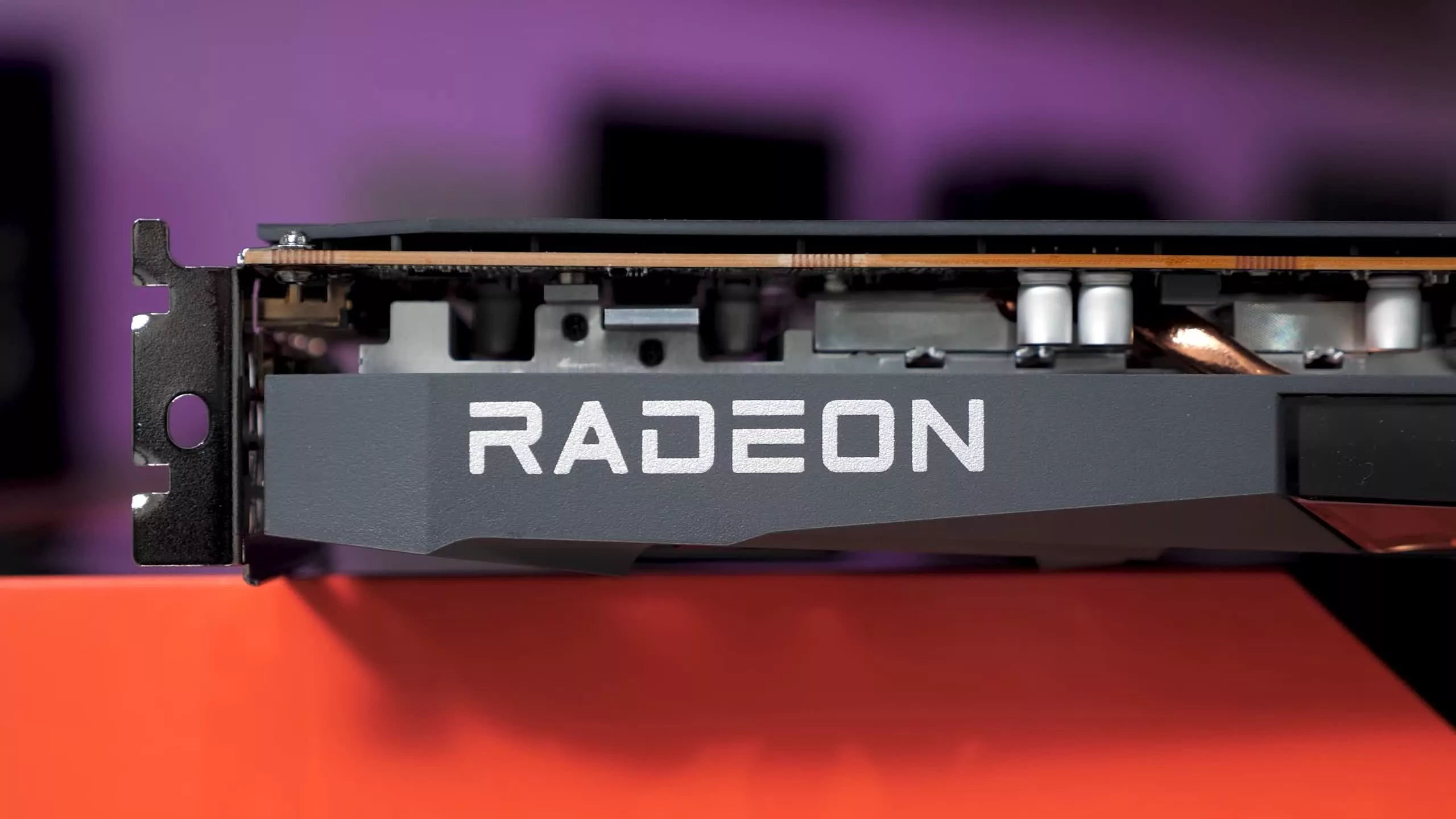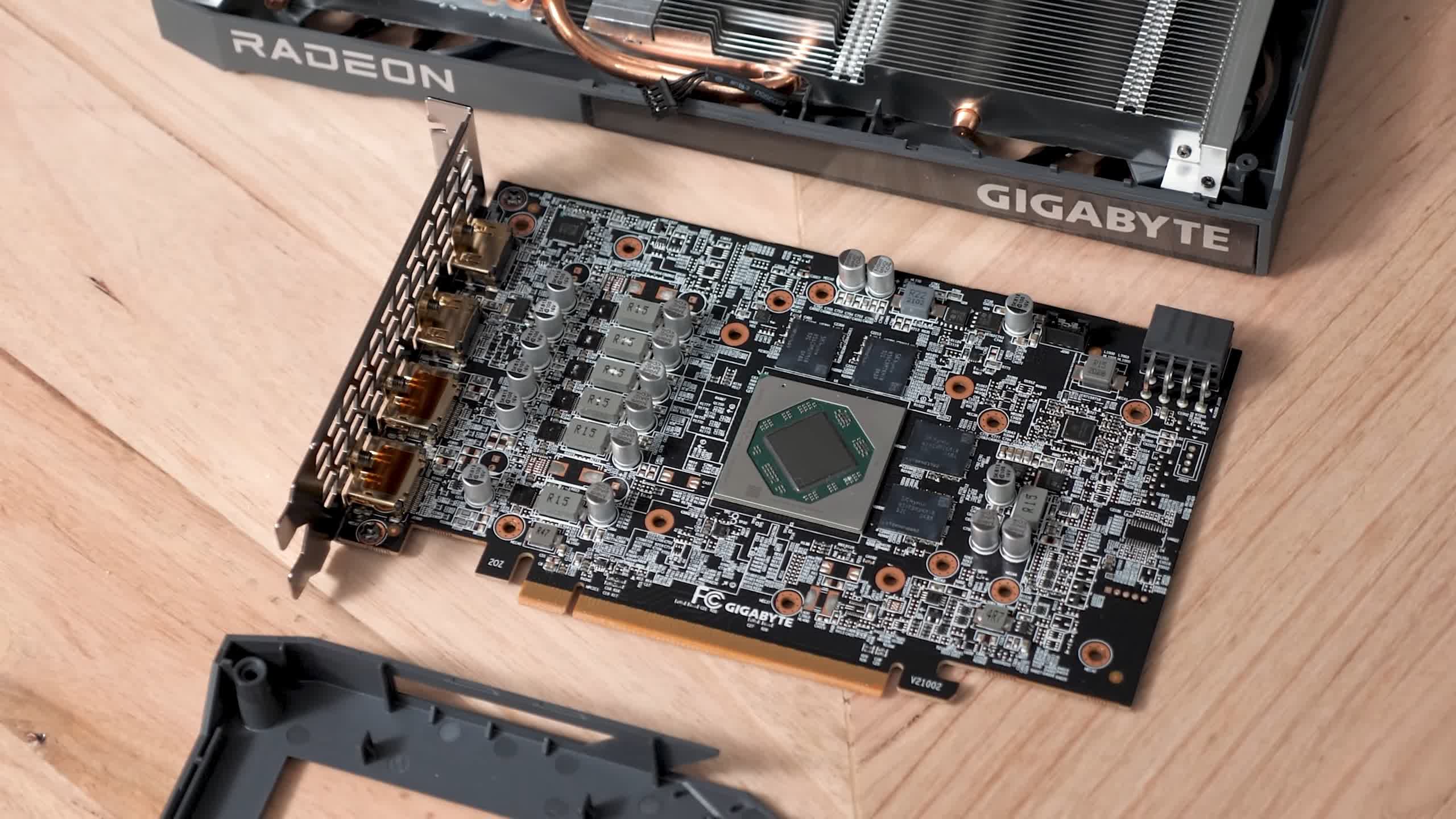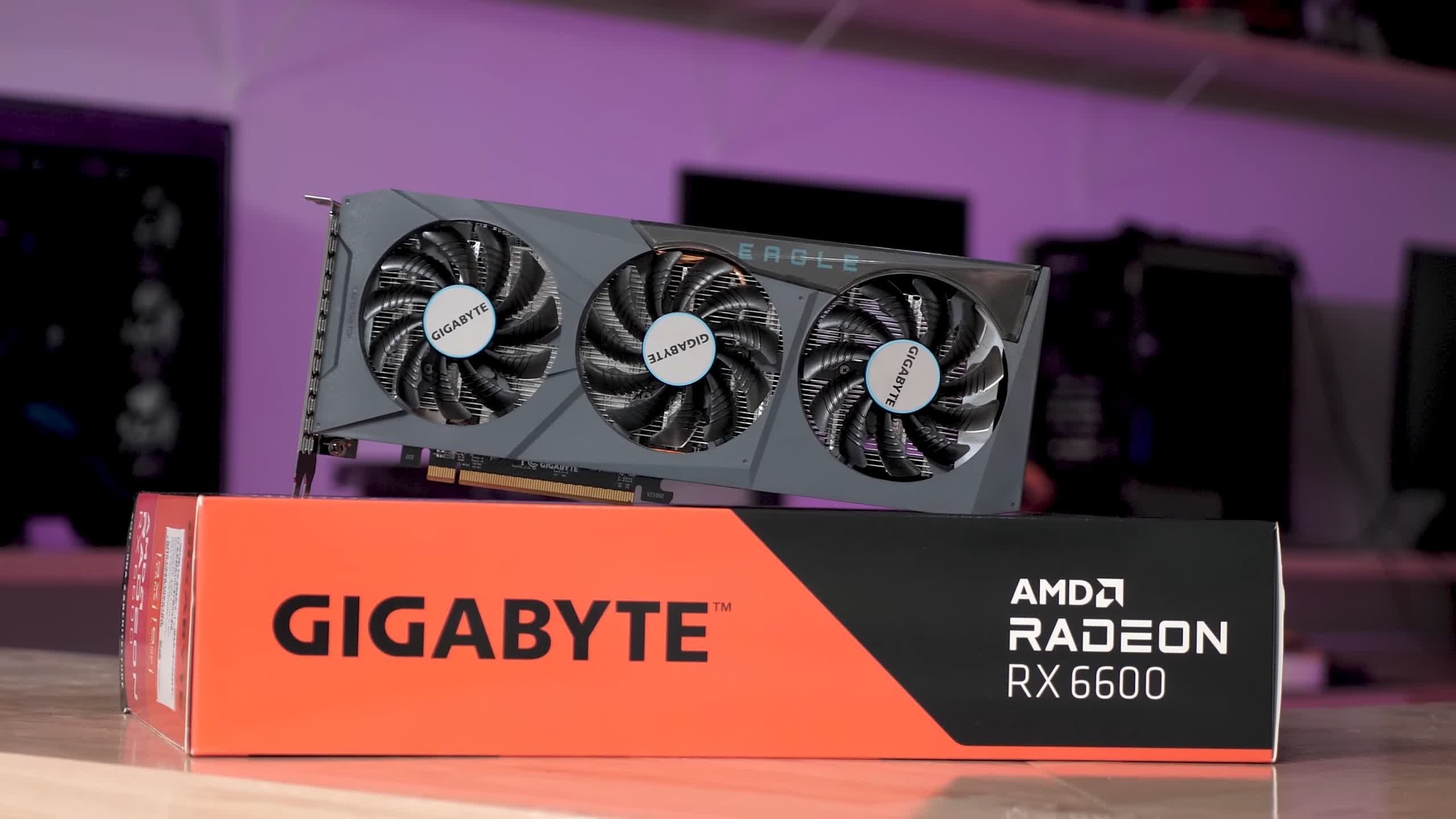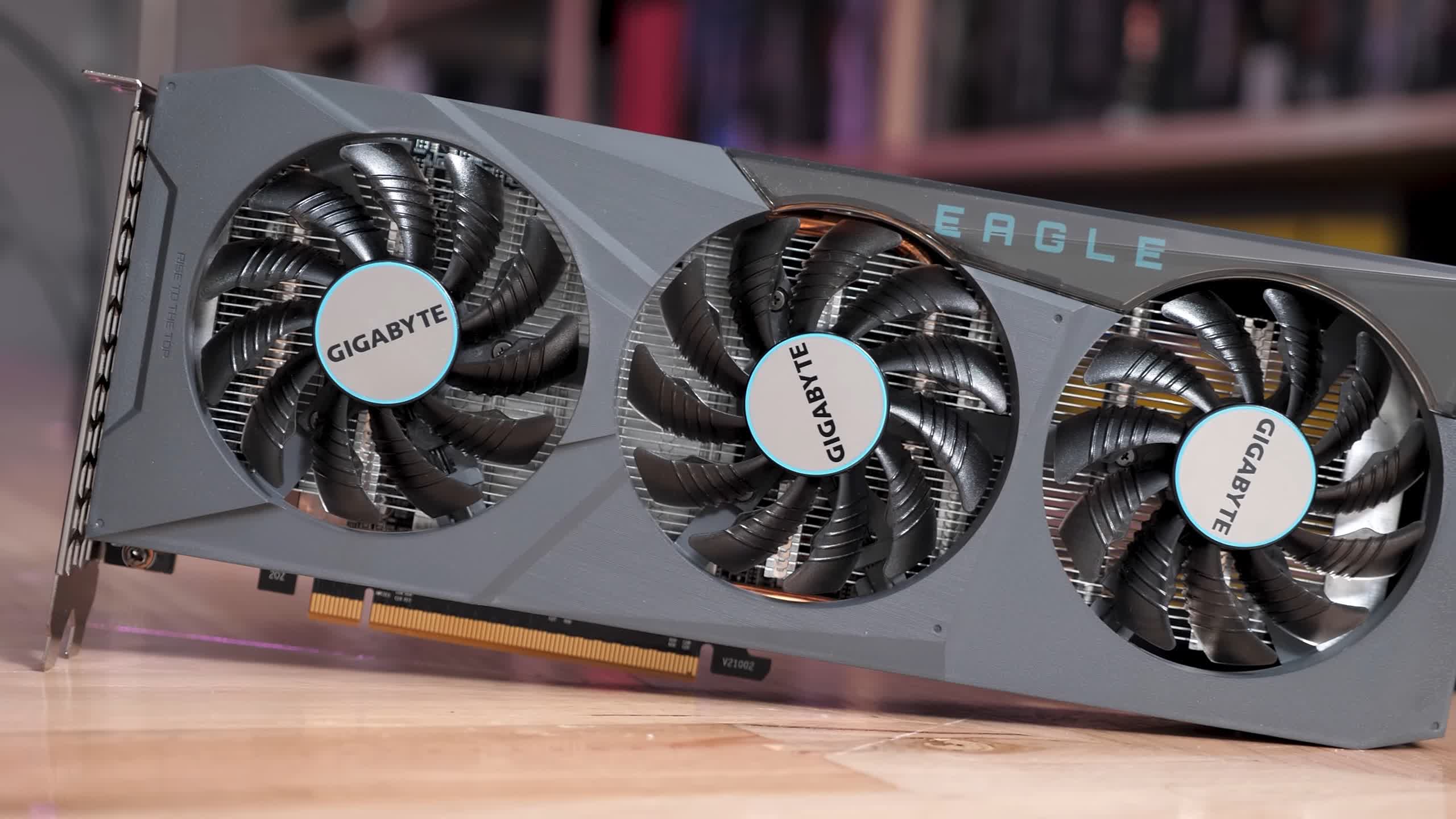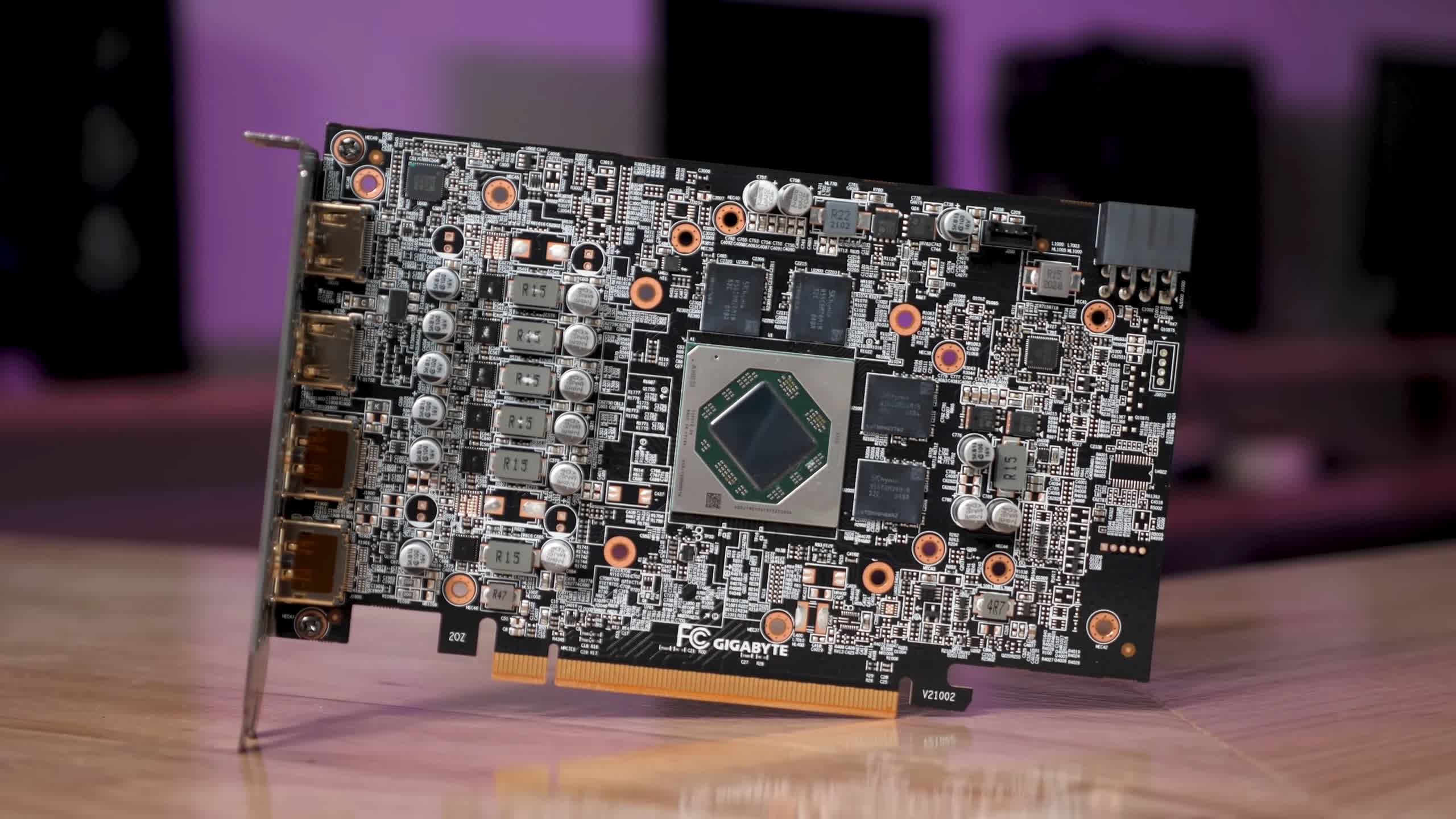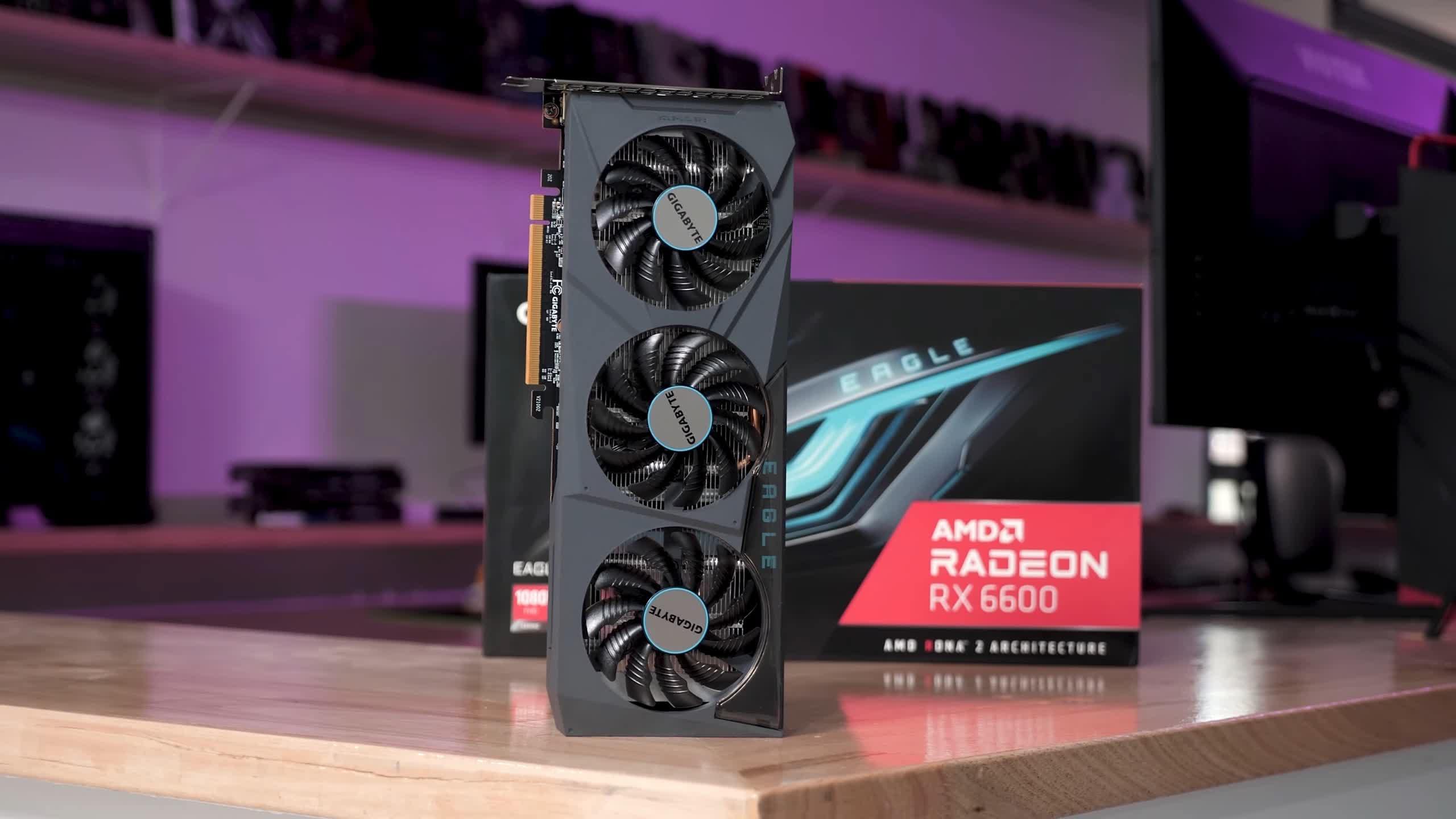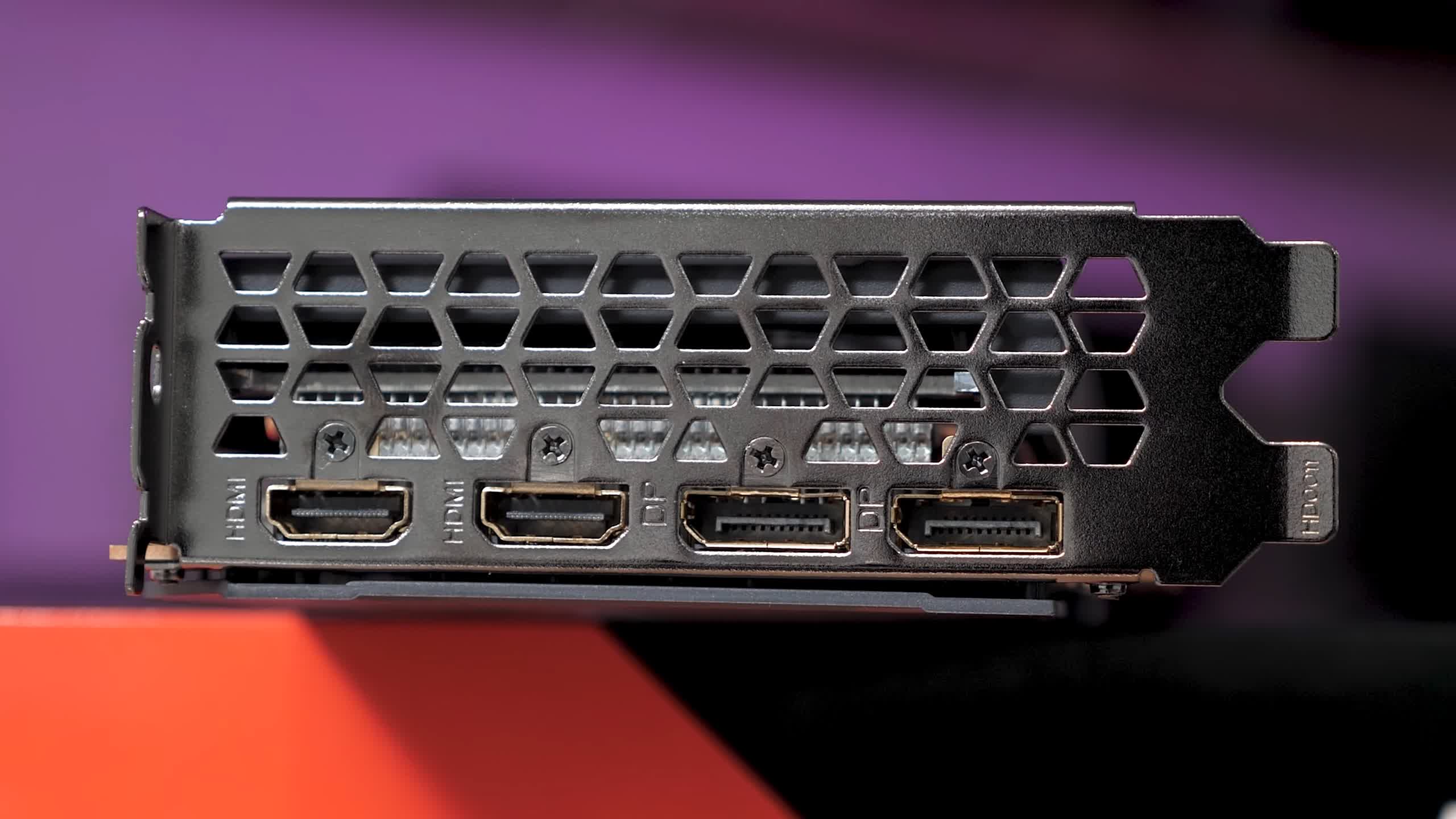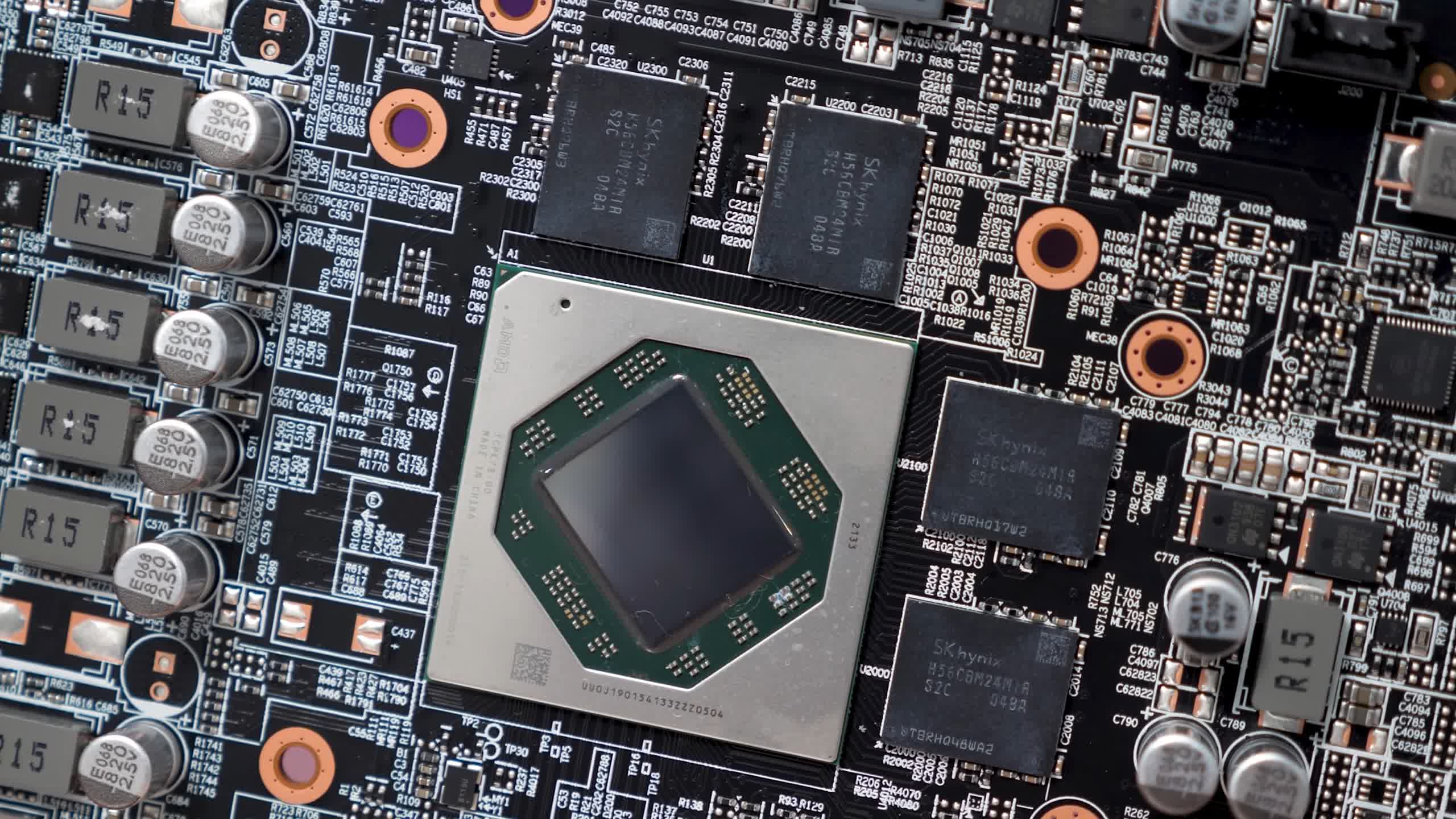AMD is releasing a new Radeon RX 6000 series product, the RX 6600, which we're reviewing today. Two months ago the RX 6600 XT arrived to a lukewarm reception as it didn't bring much to the table, the MSRP was a bit too high, even if that means nothing these days, and the performance was underwhelming.
However, one thing is list pricing and the supposed role a given GPU will have in the market, and another in the current (abnormally inflated) GPU market. And so, the Radeon 6600 XT ended up being a decent option thanks to decent availability, among the best we've seen for a new graphics card in the last year or so.
Our GPU pricing update last month saw the 6600 XT selling on eBay for $640 on average, while the slightly slower RTX 3060 typically sold for $710. That pricing remains much the same today.
| MSRP | eBay Average Price July | eBay Average Price August | eBay Average Price September | Current Price Inflation | Price Increase Aug to September | |
|---|---|---|---|---|---|---|
| Radeon 6900 XT | $1,000 | $1,460 | $1,622 | $1,569 | 57% | -3% |
| Radeon 6800 XT | $650 | $1,282 | $1,268 | $1,411 | 117% | 11% |
| Radeon 6800 | $580 | $1,087 | $1,127 | $1,309 | 126% | 16% |
| Radeon 6700 XT | $480 | $733 | $793 | $881 | 83% | 11% |
| Radeon RX 6600 XT | $380 | $633 | $639 | 68% | 1% | |
| Average | 90% | 7% |
The expectation is that there will be even more vanilla Radeon RX 6600's available at launch, so not only will you get a better chance of buying one, but hopefully you will be able to do so at a reasonable price. That's promising, though it does remain to be seen, but we'll be keeping this in mind as we check out the RX 6600.
The Radeon RX 6600 is receiving a MSRP of $330, a $50 discount from the XT model. That's a small 13% saving, a figure worth holding onto as we go over the specs. As the name implies, the new GPU a cut-down version of the 6600 XT. It's based on the same 237mm2 die packing 11.1 billion transistors, but of course, not all of them are active as the core configuration has been reduced from 32 compute units to just 28 CUs. This sees a 16% reduction in stream processors from 2048 to 1729.
The game GPU clock has been reduced by a fairly substantial 13% from 2359 MHz to just 2044 MHz, though the boost GPU clock has seen a minor 4% decrease. AMD has decreased memory performance as well, going with 14 Gbps memory and the same 128-bit wide memory bus. The decrease in memory throughput has dropped the overall bandwidth by 13% to just 224 GB/s, the same memory bandwidth as the 5500 XT, though RDNA didn't enjoy the benefits of Infinity Cache.
Thankfully, AMD hasn't downgraded the memory capacity, leaving the RX 6600 with 8GB. However, the decrease in core and memory frequency has reduced the board power rating from 160 watts down to 132 watts. Finally, like the 6600 XT, the non-XT version is limited to PCIe 4.0 x8 bandwidth. So when installed in a PCIe 4.0 system this is a non-issue, but performance related problems could arise when installed in a system that only supports PCIe 3.0, which currently is most systems.
This is because when using PCIe 4.0, the RX 6600 series connects to the CPU using a 16GB/s link which is sufficient for modern graphics cards as that's what you get with PCIe 3.0 x16. However, when limited to an x8 interface, the bandwidth for a PCIe 3.0 system is reduced to just 8 GB/s, and we found in the past this can heavily limit performance, especially when fetching data from system memory.
I looked into this with the 6600 XT and found just a single game where bandwidth limitation became an issue, and even then, it could be worked around. Still, my concern is that this limitation will rear its ugly head in the future and could mean the RX 6600 series won't age as well as Nvidia's competing RTX 3060 series, but of course, that's something we'll have to investigate in the future.
For today's testing we've got our hands on the Gigabyte Eagle RX 6600. As was the case with the XT version, AMD hasn't developed a reference card, though there's a reference PCB design which AIB partners are free to use.
In total, we've tested 12 games at 1080p and 1440p using our Ryzen 9 5950X test system which has been configured with 32GB of dual-rank, dual-channel DDR4-3200 CL14 memory. Since the 6600 is very similar to the 6600 XT in terms of design, we'll spend time analyzing just a handful of games and then take a look at the average performance seen across all 12 titles. Let's get into the results...
Benchmarks
Starting with F1 2020, we find results that are best described as predictable, with the new RX 6600 coming in 13% slower than the XT model, with 141 fps on average. That's plenty of performance at 1080p, though the RX 6600 only matched the 5600 XT which will no doubt cause many of you to cringe, given that product carried an MSRP of $280 back in early 2020, and it wasn't exactly a great deal back then. Still, when focusing on current generation products it did at least match the RTX 3060.

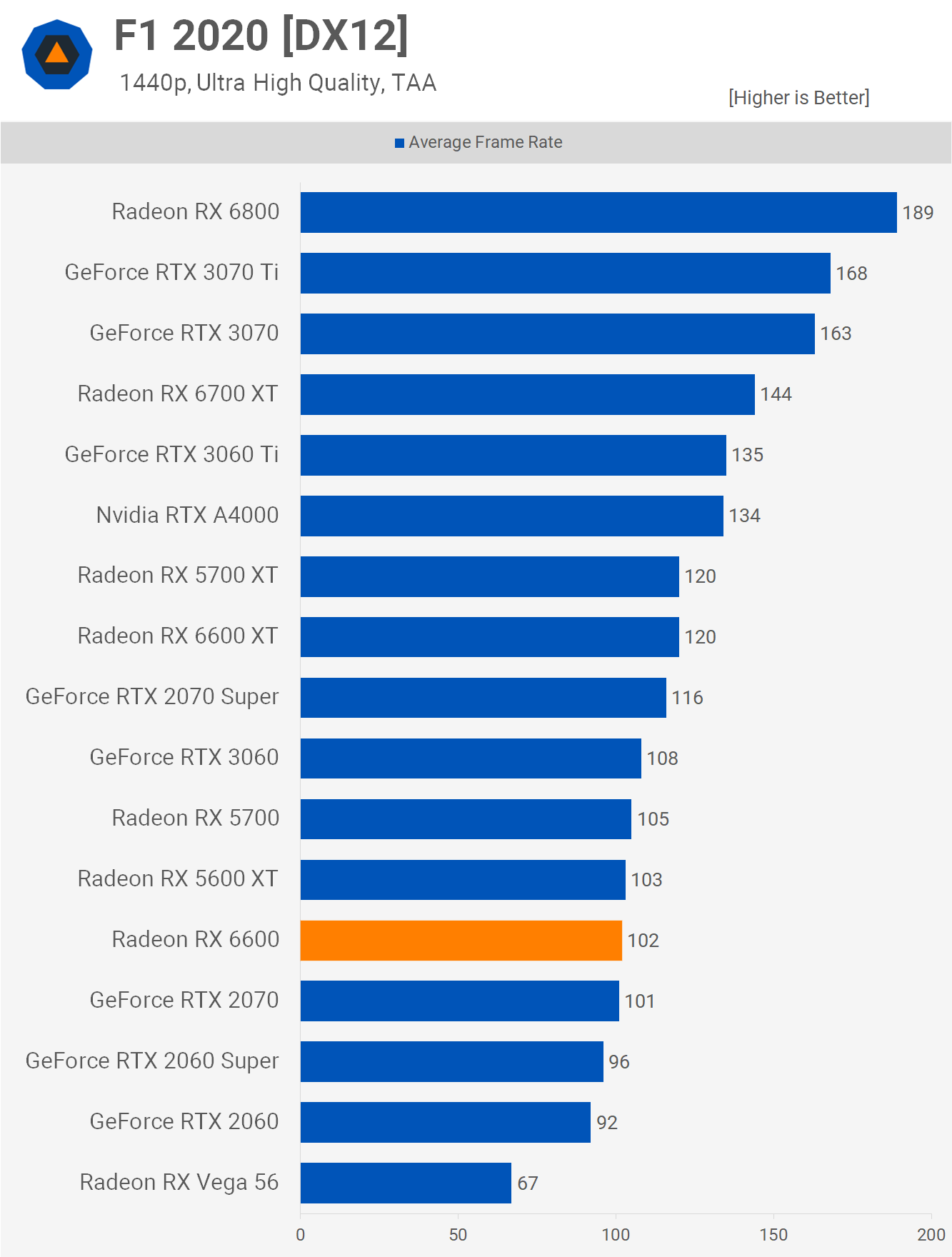
The 1440p results are less impressive as the RX 6600 finds itself towards the bottom of our graph, delivering RTX 2070-like performance, which admittedly isn't a bad result.
It does look less favorable when compared to AMD's own products with the RX 6600 only able to match the 5600 XT, so a disappointing result overall.
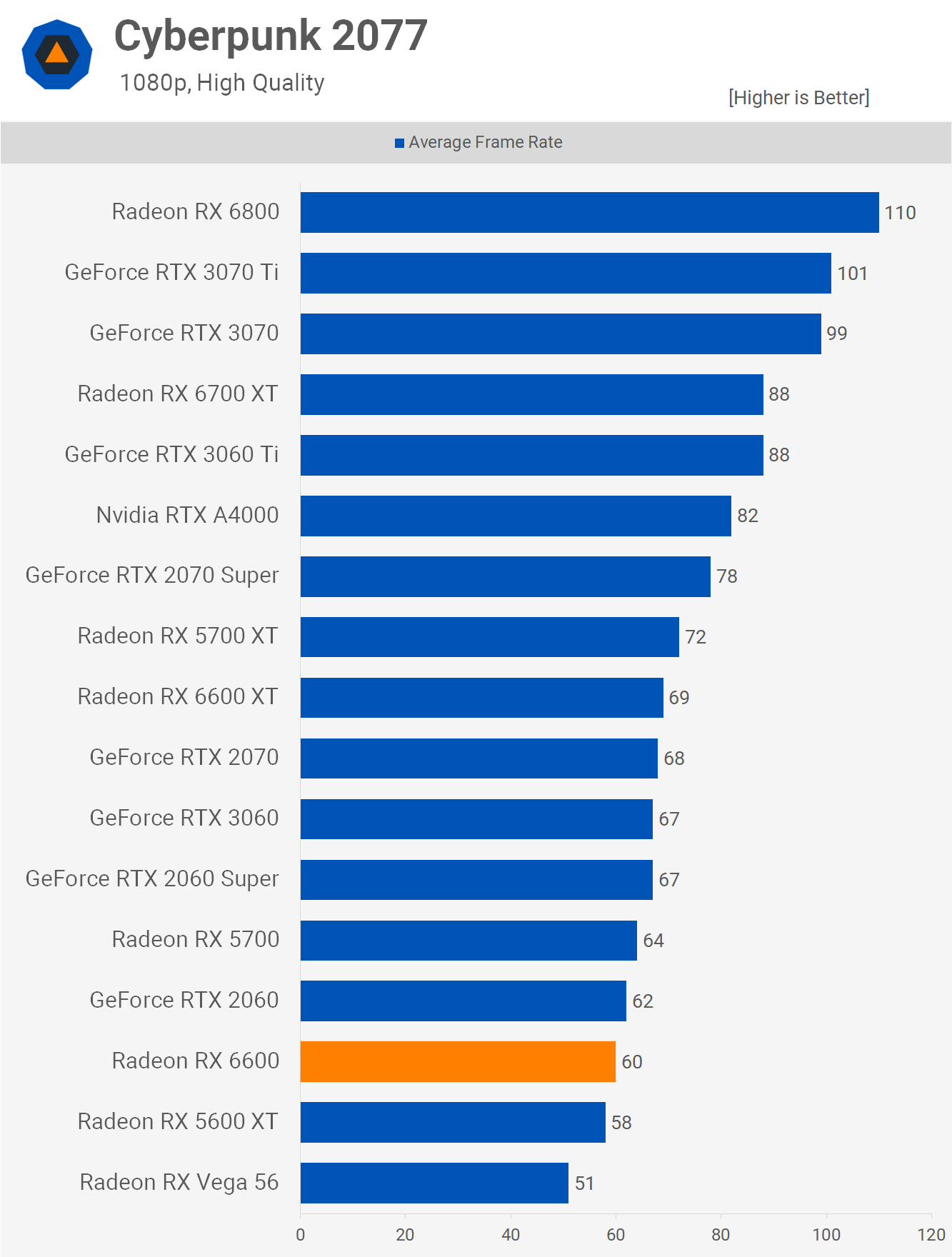
Moving on to Cyberpunk 2077, we find the RX 6600 struggling even at 1080p with an average of 60 fps, though I suppose that was to be expected given the 6600 XT rendered 69 fps, making the new variant 13% slower.
Again, we're looking at 5600 XT-like performance from the new RX 6600 and although we're comparing two different generations of GPUs that sold in two very different markets, it's still hard not to be disappointed with that result. We'll discuss this further later on the article.
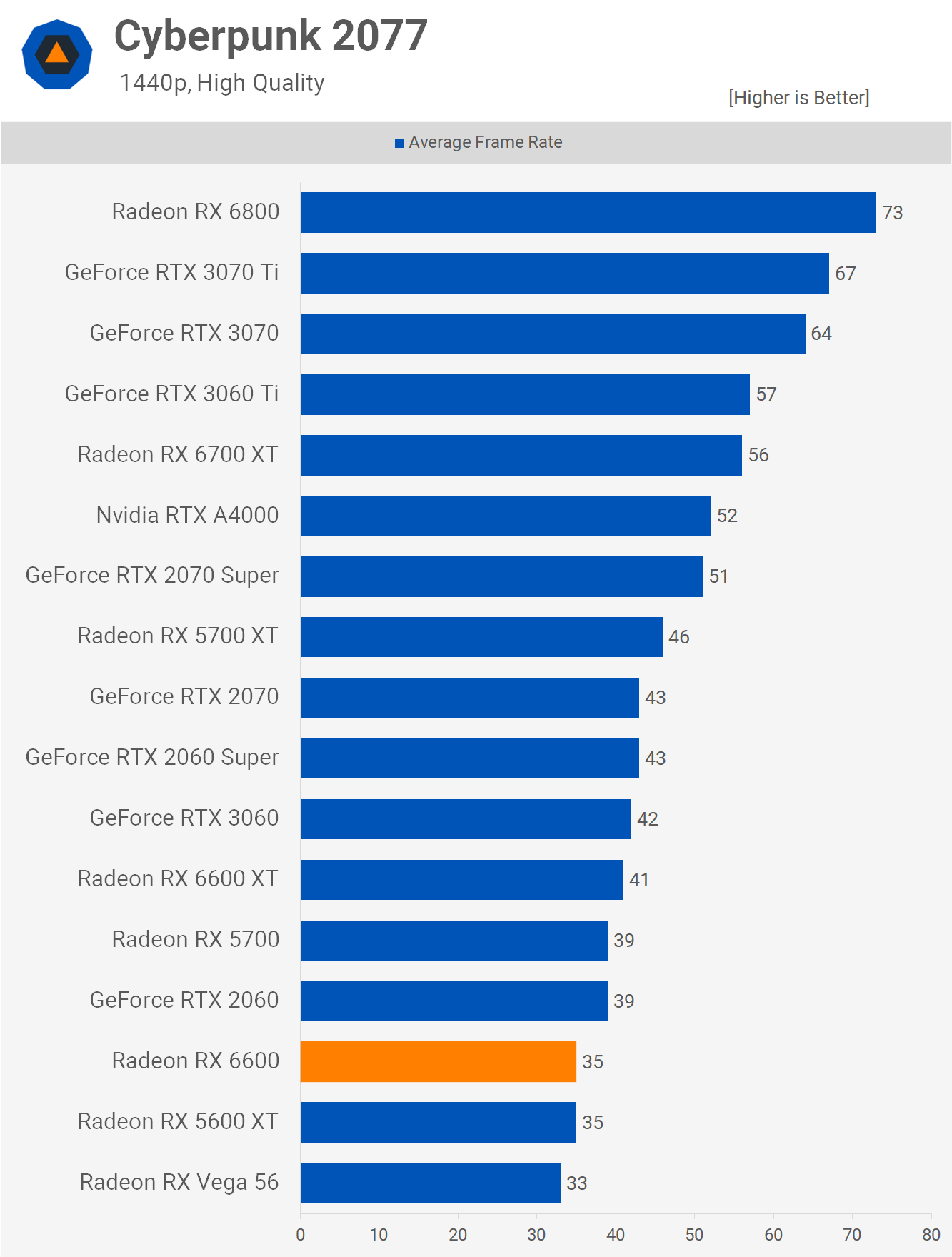
Increasing the resolution to 1440p isn't an option when playing Cyberpunk 2077 as it'll drop the average frame rate to ~35 fps and we're already using tuned quality settings.
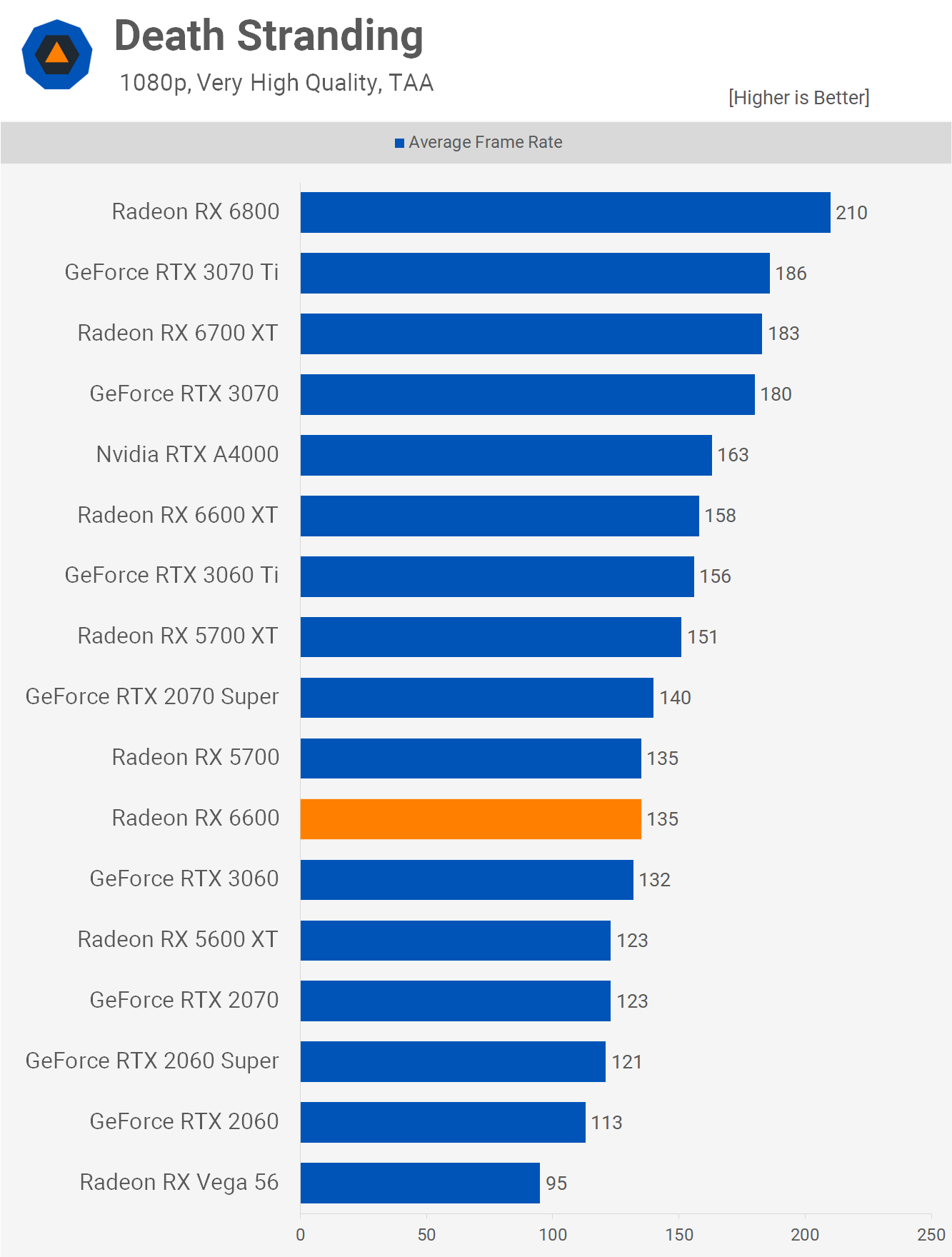
Death Stranding is more 6600-friendly as it allows for 135 fps on average at 1080p using the highest in-game quality preset. In fact, this is a much better result relative to other AMD GPUs than what we've seen previously as the RX 6600 was able to match the RX 5700 this time, making it slightly faster than the RTX 3060. Not bad given it was 15% slower than the 6600 XT.
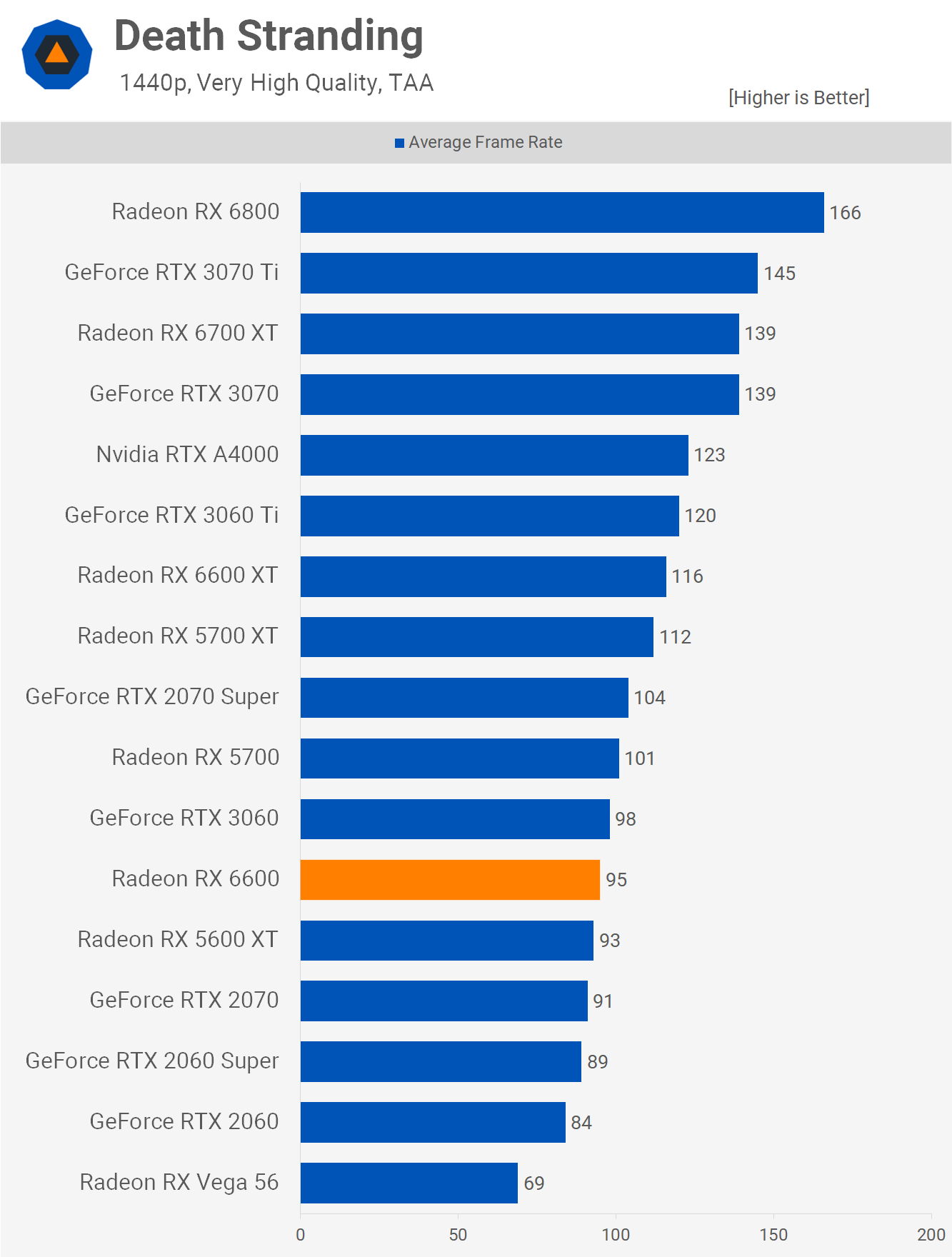
1440p is achievable here with an average of 95 fps, though that did mean that the 6600 was 18% slower than the XT version. That also meant we're looking at 5600 XT-like performance once again, which is a bit meh if I'm honest.
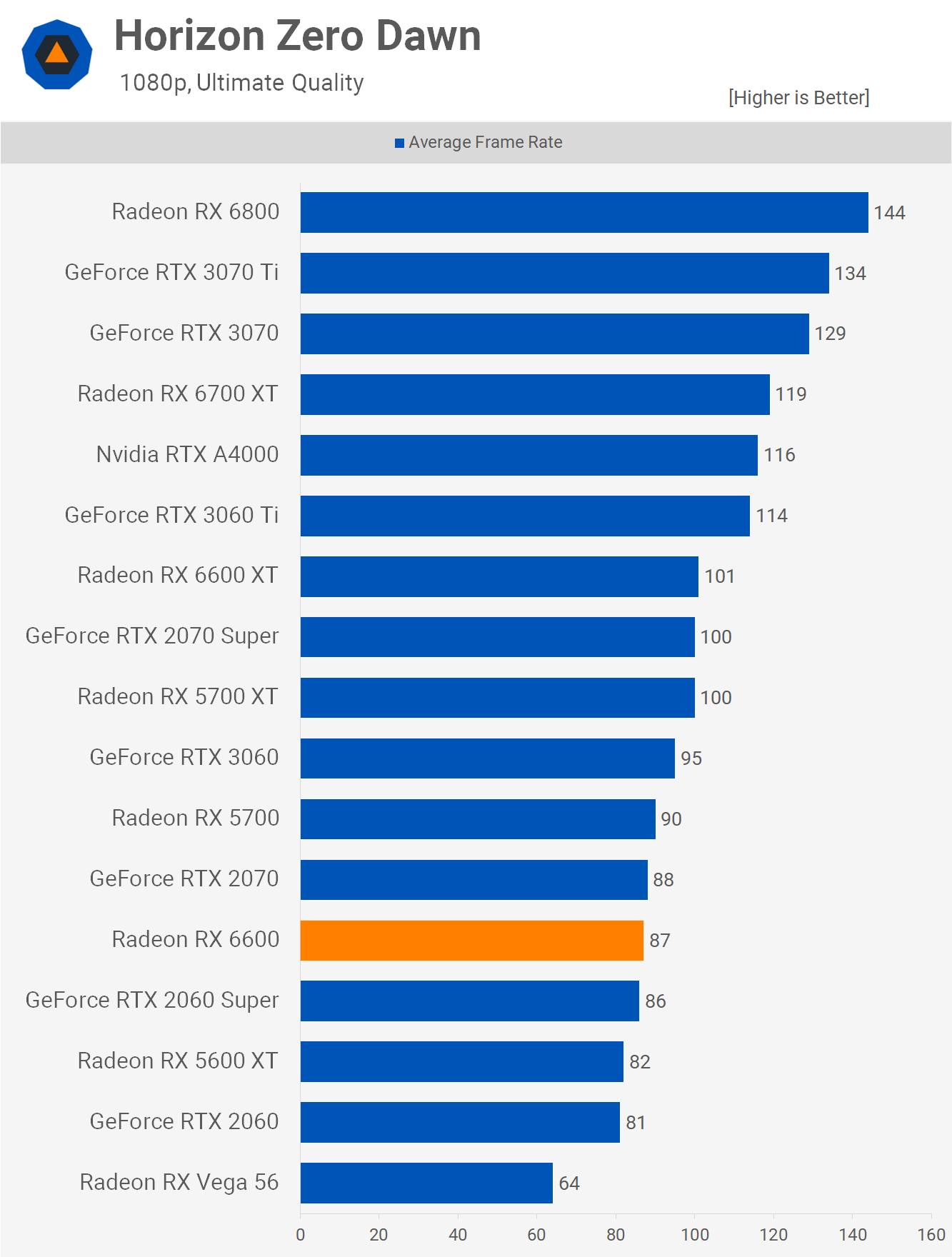
Next we have Horizon Zero Dawn and this time the RX 6600 did match the 2060 Super and 2070, so in that respect it was quite good, though it was only 6% faster than the 5600 XT, which means at 1440p they're going to deliver basically the same level of performance.
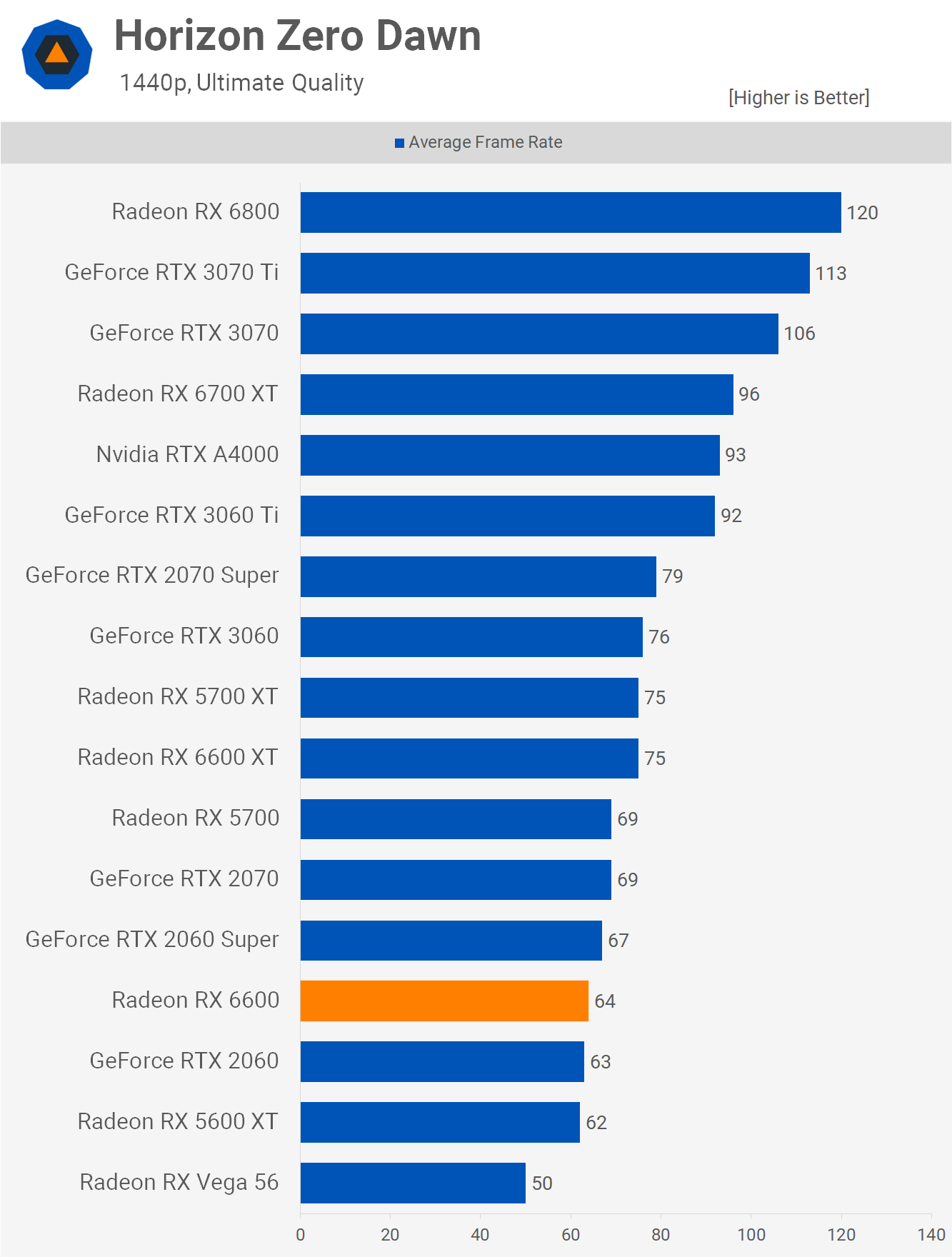
With the RX 6600 leading the 5600 XT by a mere 3% with 64 fps on average, it was also 15% slower than the 6600 XT and 7% slower than the RX 5700.
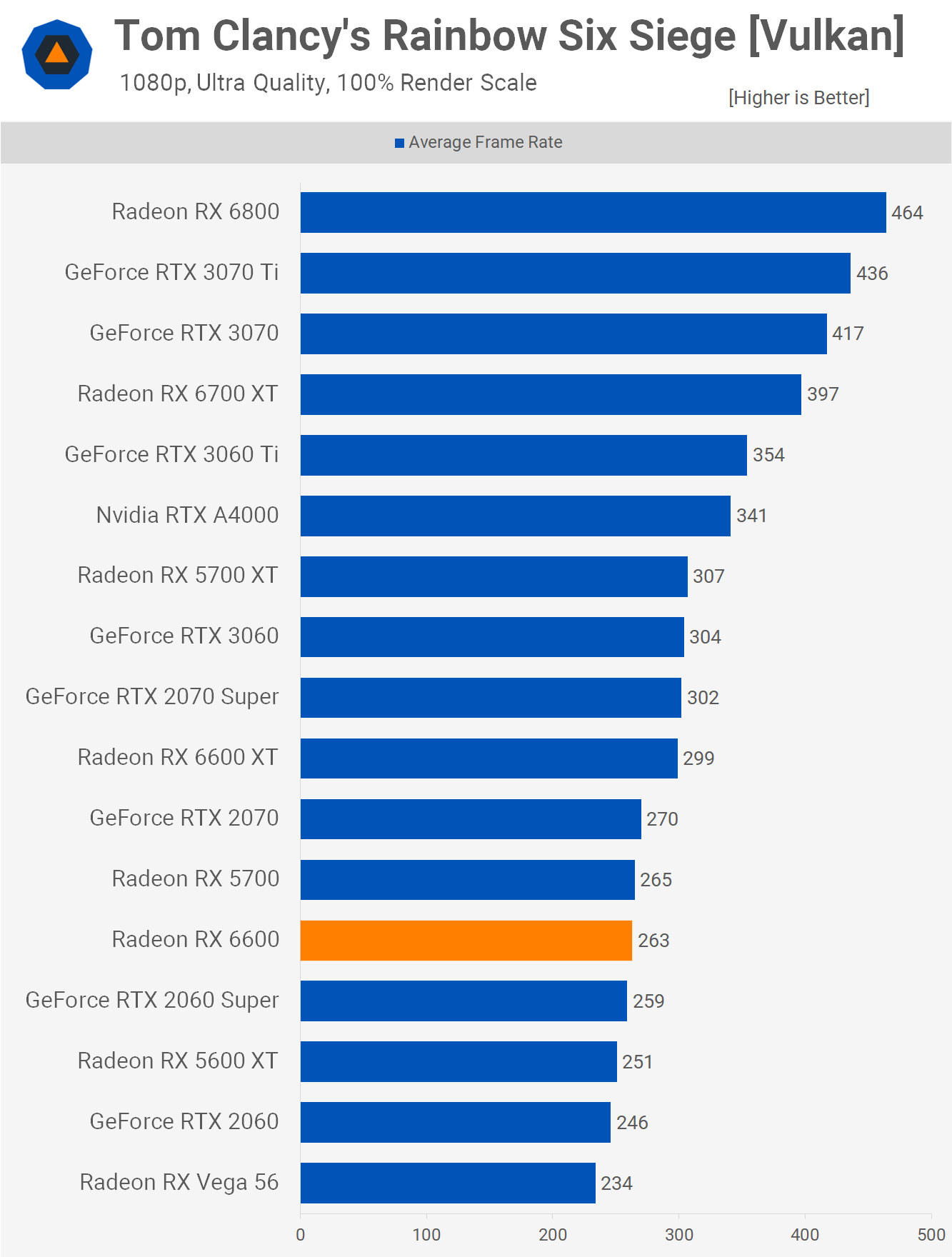
The second last game we're going to look at is Rainbow Six Siege and here the 6600 was 12% slower than the XT model, playing it between the RTX 2060 Super and RX 5700. That's just 5% faster than the 5600 XT.

That margin is reduced to just 3% at 1440p, though again it was 12% slower than the XT model. Very similar to what we've seen in other titles.
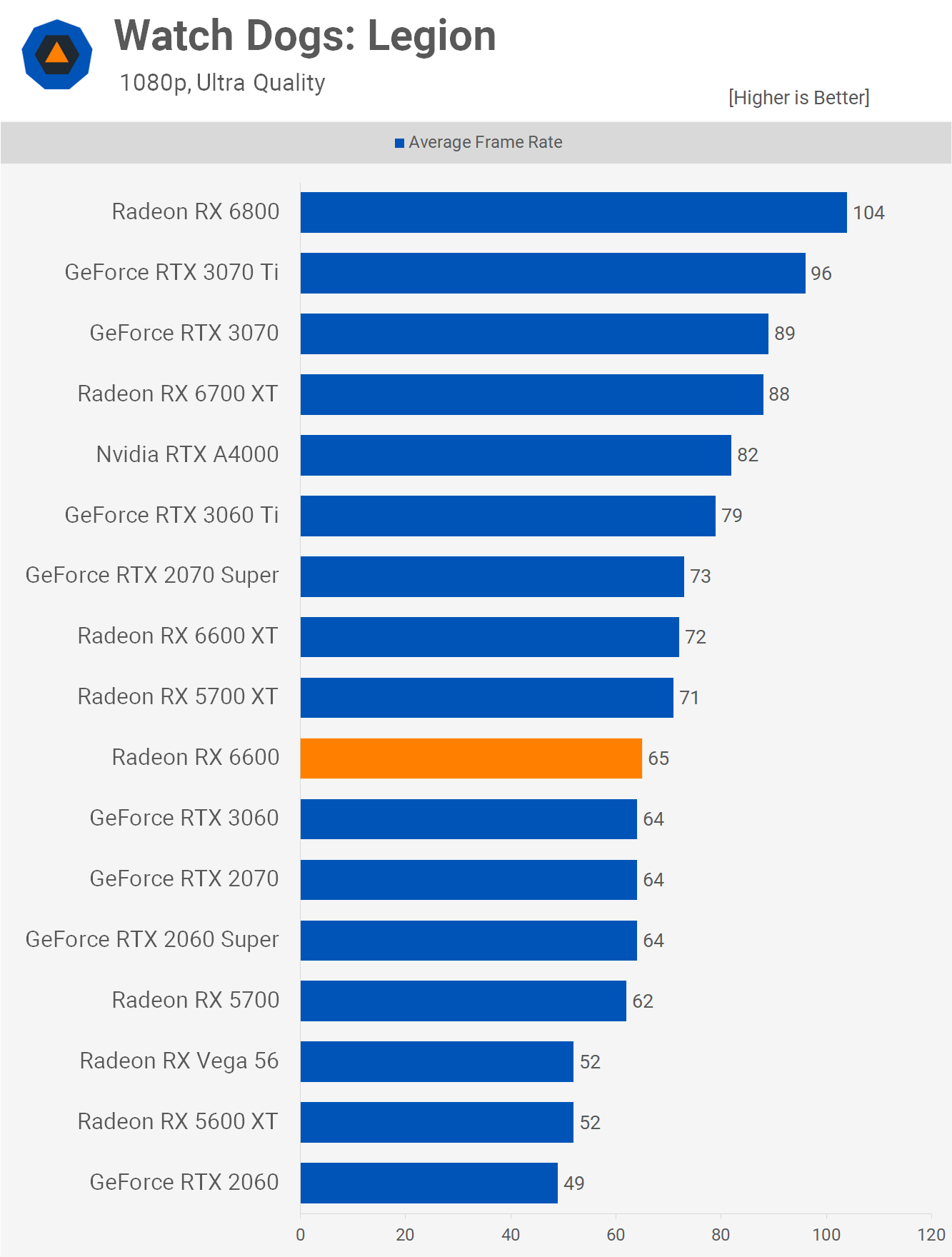
Let's wrap up the individual benchmarks with Watch Dogs Legion. The 1080p data shows that the 6600 is 10% slower than the XT model, which is a decent result and it meant the RX 6600 was able to match the RTX 3060, 2070 and 2060 Super.
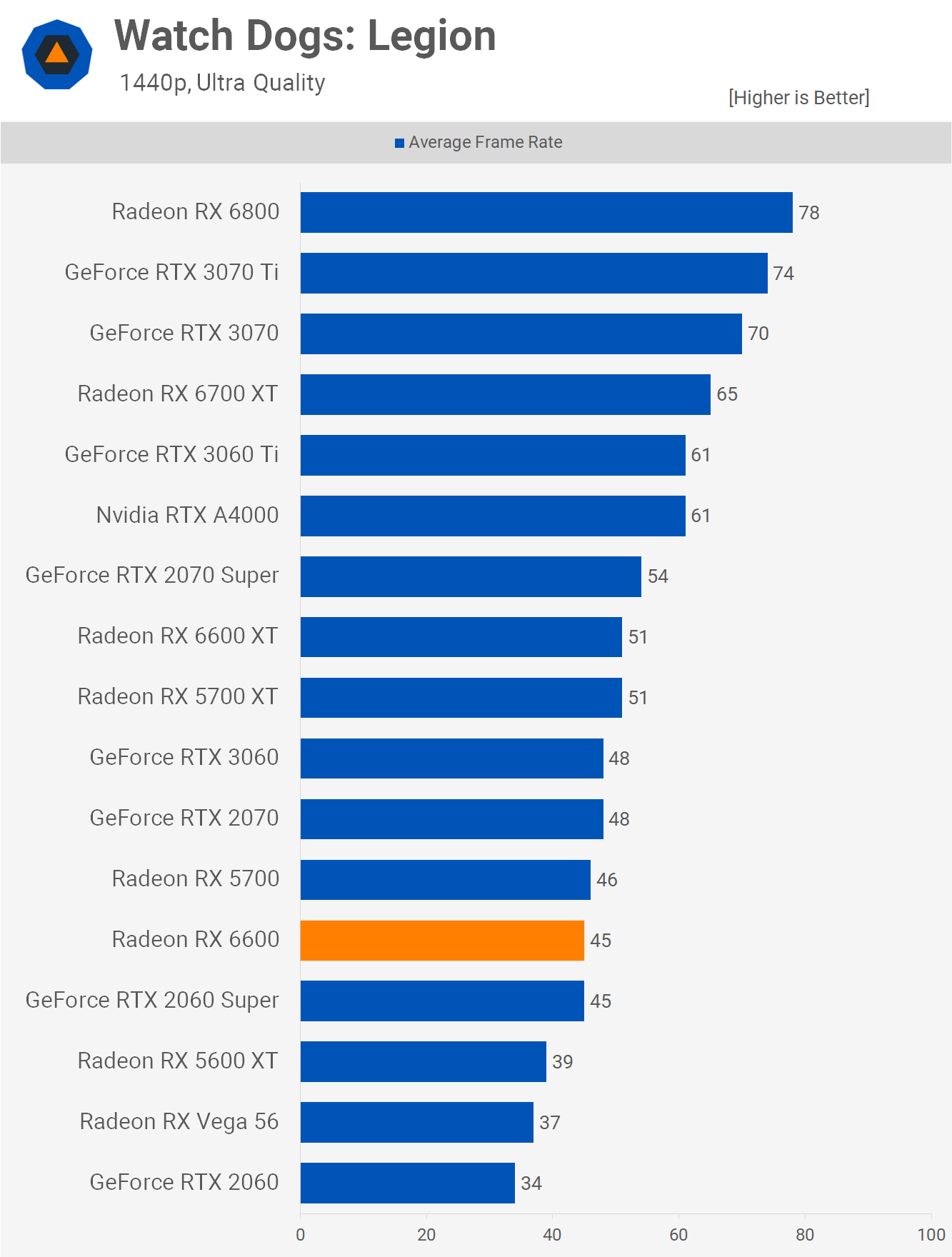
The 1440p results are fairly similar, the 6600 slips behind the XT model by a 12% margin, but still manages to match the RX 5700 and RTX 2060 Super.
Power Consumption

When it comes to power efficiency, the RX 6600 is slightly better than the 5600 XT. We're talking about a small 26-watt reduction in total system usage for roughly the same level of performance, though it was quite a bit better than the RTX 3060.
Performance Summary
The Radeon RX 6600 doesn't have any surprises for us as performance was as expected and pretty linear when compared to the XT model launched two months prior. Let's move on to check out the average performance seen across the dozen game sample...

At 1080p, the standard RX 6600 is on average 14% slower than the XT version which is in line with the price cut. Essentially, you're looking at RX 5700 or RTX 2070 levels of performance, which is decent overall, but weak in terms of progress.
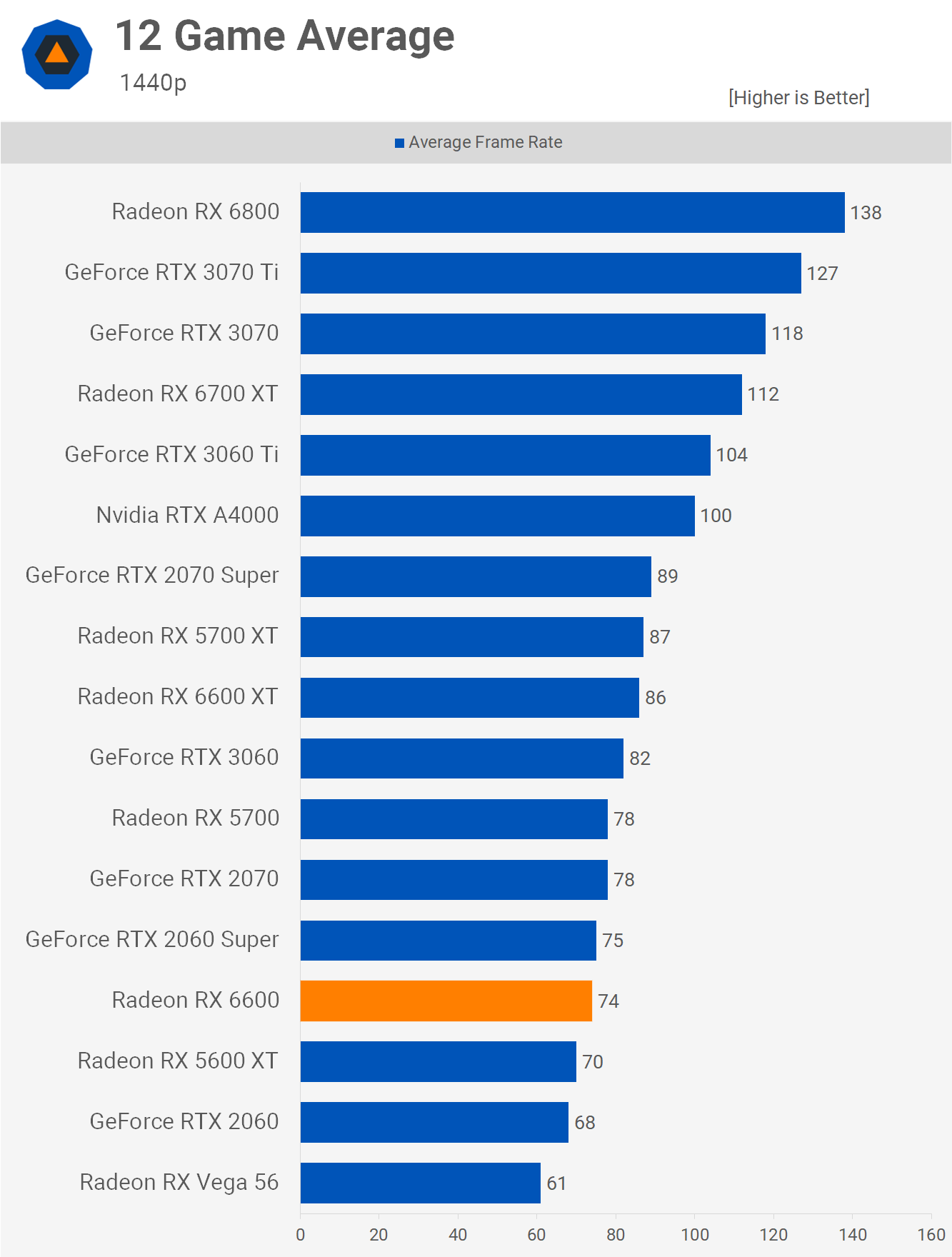
The 1440p results are slightly less favorable and although the RX 6600 was still 14% slower than the XT version, it's now only matching the RTX 2060 Super and a smidgen faster than the 5600 XT.
What We Learned
So there you have it, that's the Radeon RX 6600. Now, what to make of it?
Honestly, it's hard to say how good or bad the RX 6600 will be at launch and that will only be determined over the coming weeks, based on street pricing and availability. We've kept our ears to the ground and retailers tell us that availability will be strong, at least compared to other recent releases. If they are right, we should see even more stock than the 6600 XT launch. So that's a potential positive.
Unfortunately, cryptocurrency miners now appear to be snapping up RDNA2 GPUs, and in some places, 6600 XT pricing has shot up and most models are going out of stock. It may be possible the situation will be similar to the XT launch, where you can expect early inventory at decent, MSRP-like pricing for a few days. That stock will go out quickly though, and never be seen again.
Going back to the Radeon RX 6600's performance. Sure, in a normal market there's no denying that this product would suck. $330 would be a bad joke – a ~20% price hike over the 20 month old 5600 XT – for a ~6% performance increase at 1440p. But as it stands today, the RX 6600 could be the most affordable current-gen graphics card you can buy, so there's that.
The best option in a bad situation is arguably the best way to describe the Radeon RX 6600, so let's leave it at that for now.
There's the chance you have a working GPU that is faster or close to this already, thus it's not going to be worth the upgrade. So the RX 6600 is more of an option for those without an alternative. If you want to game right now and can't, so the RX 6600 may become a cost-effective way to get gaming.
Bottom line, the Radeon RX 6600 is just like the 6600 XT, an uninspiring product made palatable only by the current climate. It does feel wrong recommending any graphics card right now, especially one that wouldn't be good value, or anything remotely close to, in a normal market. That being the case, you absolutely shouldn't buy a graphics card right now if you don't need to, but if you do, the 6600 is probably going to be the decent option.
